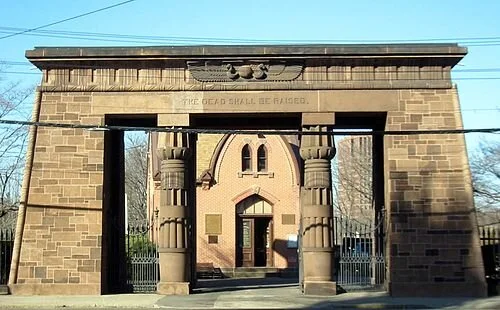
Deborah Danger: Estate planning for college students in the pandemic
“Death on the Pale Horse’’ (1865), by Gustave Dore
Entrance to the Grove Street Cemetery or Grove Street Burial Ground, in New Haven, Conn. It’s surrounded by the Yale University campus. The cemetery was founded in 1796 as the New Haven Burying Ground and incorporated in October 1797 to replace the crowded burial ground on the New Haven Green. Many notable Yale and New Haven luminaries are buried in the cemetery, including 14 Yale presidents.
From The New England Journal of Higher Education, a service of The New England Board of Higher Education (nebhe.org)
NEWTON, Mass.
Eleanor Roosevelt once said, “If life were predictable it would cease to be life, and be without flavor.”
Her words are excellent guideposts as New England colleges and universities navigate the unknowns of educating students during COVID-19. Despite the precautions that institutions are taking, on-campus teaching and research are not totally risk-free.
Neither, of course, is life itself.
As COVID-19 and the upcoming flu season pose new uncertainties, many faculty and administrators are brushing up against less comfortable topics, including extended illness, incapacity and death.
Over the past few weeks, up to 80 percent of the calls I have fielded were from educators and high school and college students wanting to put together estate plans, or update previous plans, as they return to the classroom. These included a 17-year-old high school student who drafted a plan and then signed it on his 18th birthday and two college freshmen who wanted these documents in place before heading to their new campuses.
My informal survey of potential clients finds that less than half have estate planning documents in place, and many who already have them in place discover that named agents have moved away or died, and previously proclaimed wishes no longer accurately reflect their current wishes. The educators and administrators who are taking action now have been spurred on by new “what if” scenarios (e.g., “If I am put on a ventilator and can’t make my wishes known, who will speak for me?” “If both my partner and I become ill, who will care for the children?”).
Estate plan elements
Estate planning is a way for individuals to ensure that: 1) their values and personal priorities will be known and honored, 2) their wishes for their family will be protected and 3) their assets will be available to provide for loved ones.
These plans include:
A will, which specifies who is to receive prized possessions and other assets when they die … including charities. It is also where they name guardians for their minor children.
A healthcare proxy, which specifies the person who can make healthcare decisions for them when they cannot. This document should be supplemented with a Health Insurance Portability and Accountability Release (HIPAA), so doctors can share their medical information with the proxy.
Revocable living trust … In most states, a will does not authorize the bypass of probate or the immediate distribution of assets upon a person’s death. The addition of a trust, in most cases, enables heirs to quickly receive what has been left to them. Naming trustees of the trust also provides protection against irresponsible spending by heirs, and premature spending by minor children.
A durable power of attorney, which grants a trusted spouse, partner, friend, relative or advisor the power to handle their finances and affairs if they become incapacitated.
Moreover, because of the nature of their work, professors should also think about:
Whether they need a literary executor (to oversee written works).
Ensuring the continuity and value preservation of “side hustles,” such as part-time teaching or tutoring gigs or running a blog or small company.
Ownership of intellectual property, such as patents, websites and creative works.
Getting personal
What about the softer and more human side of this process?
Estate planning is an opportunity to express very personal considerations about measures that should be taken to extend life, such as preferences about the use of ventilators and being artificially fed and hydrated. It’s also a way to direct a “legacy of love” and document who should give away and get possessions that have value and possessions that preserve memories. The clearer individuals are about these things, the easier it will be for their family, community and friends to honor their wishes rather than guess and argue over what they are.
For these reasons, individuals should be thoughtful and thorough, and make sure to work with a trusted advisor who can help them think through decisions about these challenging choices.
Once the conversations have been had, and estate planning documents are signed and notarized, the temptation is to close this chapter, but this is the time to share information with everyone who might require it. If one suddenly contracts a more serious case of COVID-19, it is important that every agent/decision-maker can act quickly and in synch with everyone else.
Individuals should share:
Healthcare proxies: Not only with the designated proxies, but also with each of their caregivers and specialists, their hospital of choice, employers (for Human Resource folders, so colleagues know who to call and which hospitals to request in the event of a sudden illness) and fitness centers (in the event of a heart attack, stroke or injury while working out).
Durable powers of attorney: In addition to the designated “agents,” others who would benefit from this information include banks, insurance providers, financial advisors, CPAs and college/university employers.
Will: At least one trusted person should know where the original will is kept, as this document must be filed with the court upon death (copies will not be considered valid).
Trusts: These instruments will set in motion a chain of other actions that need to be implemented in order for their full benefits to be realized; for example, all assets, including real estate, will need to be retitled in the name of the trustee.
Indeed, this is a good time to centralize all important documents in case of an emergency—from titles and deeds to birth and marriage certificates. For a checklist, click here.
COVID-19 is a wakeup call for all of us that life can instantly change. An estate plan offers a measure of control, enabling one to protect loved ones as they continue their educational work.
Deborah Danger is managing member of DangerLaw, LLC in Newton, Mass., which focuses on estate planning, post death administration, asset protection, family law, small business/entrepreneurship advising and collaborative law.
The weirdness of New Haven's Lincoln Oak
 "Vigor Code,'' by JOE SLOMBA, in the "Nothing Is Set in Stone: The Lincoln Oak and the New Haven Green'' show, at the New Haven Museum, though Nov. 2.
"Vigor Code,'' by JOE SLOMBA, in the "Nothing Is Set in Stone: The Lincoln Oak and the New Haven Green'' show, at the New Haven Museum, though Nov. 2.
This is one of the strangest shows in a while.
As the museum puts it: The show combines ''contemporary art with archaeological analysis....''
"In October 2012, winds from Hurricane Sandy toppled the mighty oak — planted in 1909 to commemorate the 100th anniversary of Lincoln's birth — revealing human skeletal remains in the tree's exposed roots and creating an enigmatic narrative that captured the imagination of the entire country.''
"Artists to be featured in the exhibition were invited to use branches, limbs or pieces of the trunk of the Lincoln Oak to interpret the history of the tree and the discoveries yielded beneath it. Zeb Esselstyn, renowned for his own work in transforming fallen trees into artistic and functional furniture, distributed the wood to the artists in February 2014....''
"Jeff Slomba {above} paid tribute to the fallen Lincoln Oak through his amalgamation of oak branch, steel, 3-D printed PLA plastic and sparklers. Slomba mused that the tree's destruction by Hurricane Sandy 'revealed not only the tree's own vulnerability, but also the mortality and slippage from history's memory of those who came before us.'''
''The scientific component of the exhibition consists of the results of the on-going archaeological analysis of human remains recovered from the site. Photo panels describe the remains ... and how they were used to determine the gender and approximate ages of those whose remains were unearthed in October 2012, and offer hypotheses on health and disease issues of the interred. The contents of two time capsules found at the site of the fallen Lincoln Oak are also on display.''


